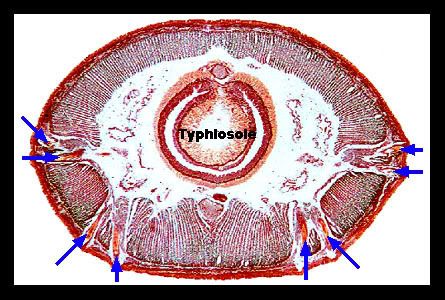Respiration:
Annelids have no lungs, but many have gills for respiration. Respiration occurs by diffusion through the moist surface of the body. That's why earthworms die so quickly when their epidermis dries up. Most polychaetes also have gills to aid in respiration.
Response to the environment/Movement:
Annelids have various muscle groups and simple appendages. They use setae and parapodia for movement. Annelids such as the earthworm and the Lumbricus possess setae. A seta is a stiff hair, bristle, or bristle-like part of an organism. The setae are able to move in and out from the body wall. When the setae are withdrawn, the body extends, and the worm moves forward. Setae help earthworms attach to the surface and prevent backsliding during peristaltic motion. Parapodia (para = like; pod = foot) are mostly found in polychaetes and can extend and retract. Parapodia are paired, lateral appendages extending from the body segements.

Setae shown on the cross-section of a Lumbricus terrestris
Reproduction:
Annelids can reproduce asexually and sexually depending on the type of species.
Asexual Reproduction:
Asexual reproduction is by fragmentation, budding, or fission. Fission allows Annelids to reproduce quickly. The posterior part of the body breaks off and forms a new individual. For example, Lumbriculus and Aulophorus, are known to reproduce by the body breaking into such fragments. Many other species (such as most earthworms) cannot reproduce this way, though they have varying abilities to regrow amputated segments.

Lumbriculus variegatus
Sexual Reproduction:
Hermaphodites are common within Annelids, but others have seperate genders. Sexual reproduction allows a species to better adapt to its environment. Fertilized eggs of marine annelids usually develop into free-swimming larvae. Most polychaete worms have separate males and females and external fertilization. The earliest larval stage, which is lost in some groups, is a ciliated trochophore (type of larva with several bands of cilia), similar to those found in other phyla. The animal then begins to develop its segments, one after another, until it reaches its adult size.
Earthworms and other oligochaetes, as well as the leeches, are hermaphroditic and mate periodically throughout the year by copulation. Two worms lay their bodies together with their heads pointing opposite directions and sperm is transferred from the male pore to the other worm. Other methods of sperm transference have been observed in other genera and may involve internal spermathecae (sperm storing chambers) or spermatophores that are attached to the outside of the other worm's body. The embryonic worms develops in a fluid-filled "cocoon" secreted by the clitellum (a thickened glandular section of the body wall that secretes a viscid sac in which the eggs are deposited).

The clitellum on an Earth worm
http://library.thinkquest.org/28751/review/animals/5.html
http://www.biologyreference.com/Mo-Nu/Nervous-Systems.html
http://userwww.sfsu.edu/~biol240/labs/lab_17hydrostaticsk/
pages/annelid.html


1 Comments:
This is so cool. Thanks for the informations. Try to check this too
DogsNStuff.net
Post a Comment
Subscribe to Post Comments [Atom]
<< Home